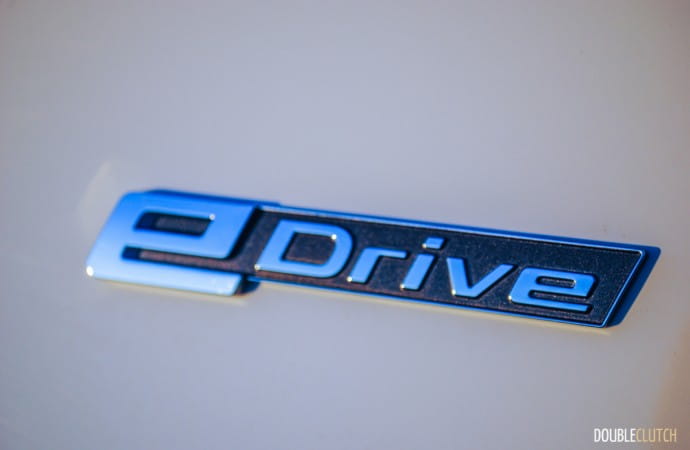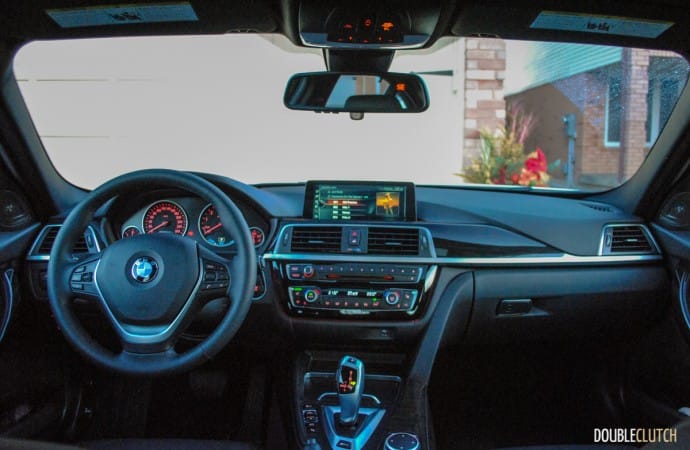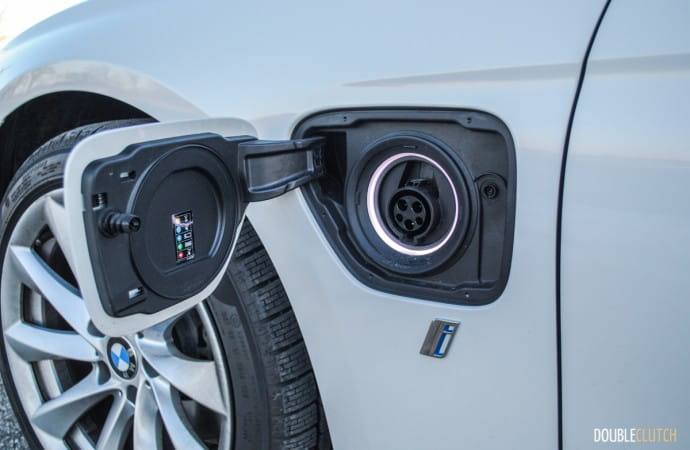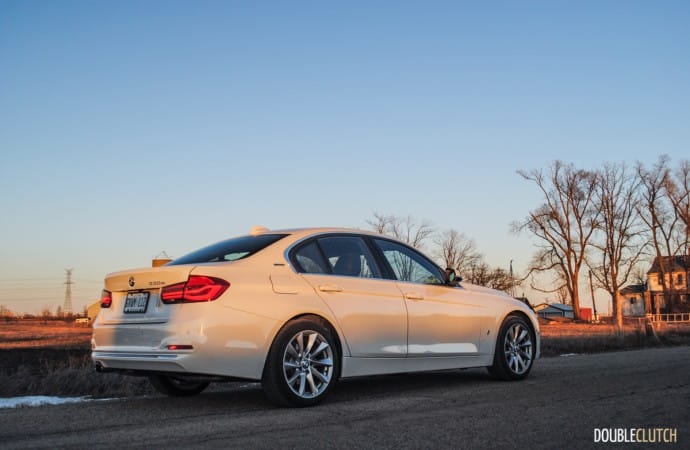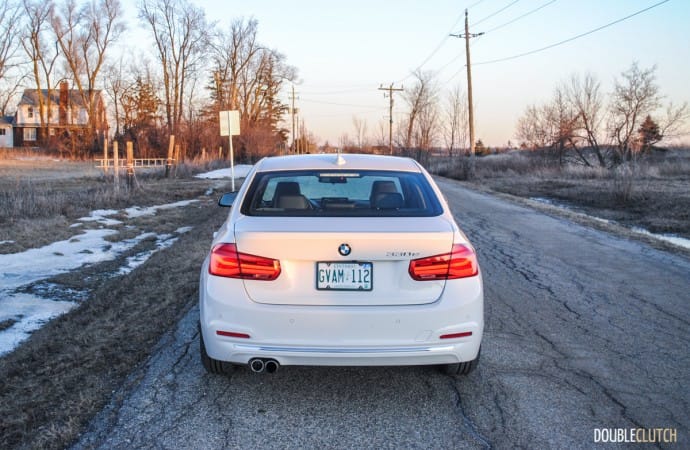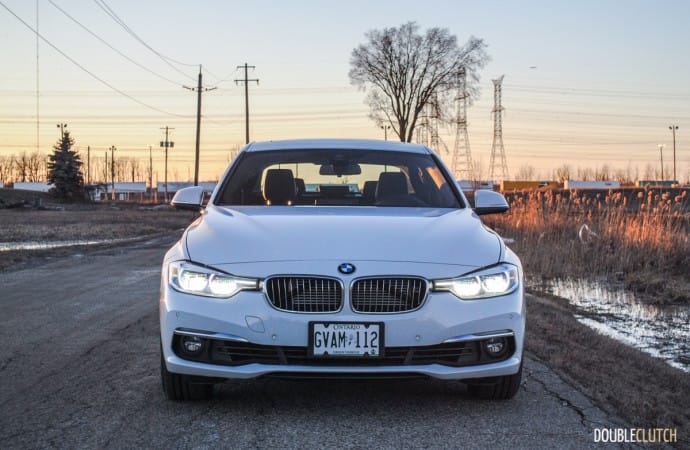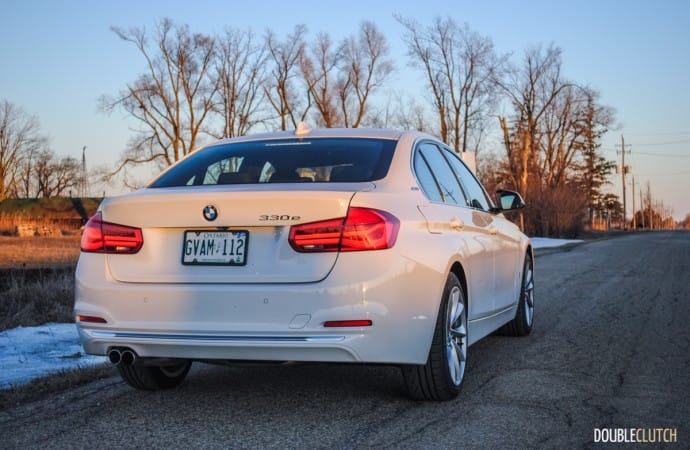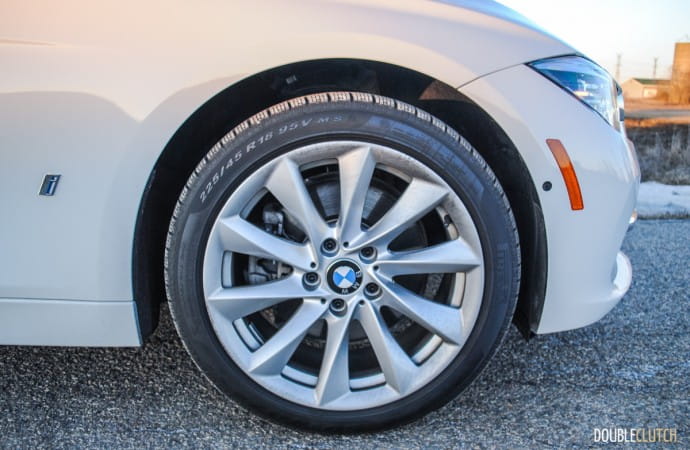The BMW 3-series has been widely regarded as setting the standard for engaging sedans, and has earned itself a strong following among a wide group of consumers, from hardcore driving enthusiasts to simple commuters looking for something a little more upscale. Now though, the 3-series has set its sights on the growing eco-friendly segment with the new 2017 BMW 330e iPerformance. This car combines BMW’s plug-in hybrid technology with the high performance driving dynamics it’s known for. The concept is simple; low consumption expected from a plug-in hybrid, and the world-class driving dynamics that put this sedan on the map.
Fortunately, BMW has kept things extremely simple from a styling perspective, with very little to distinguish the 330e iPerformance from its simple fuel fed brethren. The most obvious clue on the outside of the car is the big charging port on the front fender. Beyond that, call-outs are limited to a couple e-drive logos and the “330e” badging on the rear deck lid. Finished in crisp Alpine White and riding on nice 18” wheels, this particular car does a really good job showcasing the sporty interpretation of traditional sedan design. While one can certainly debate the merits of where BMW has taken their styling, it would be difficult to argue that the current 3-series is not a great looking car.
The inside of the 330e follows a similar story. In general, the interior finish and layout of the 3-series hasn’t changed, however it’s been continually refined and upgraded to a point where the space is a very nice place to be. Again, very little inside the 330e changes in order to accommodate the plug-in hybrid equipment. There is a power flow display you can pull up on the in-dash screen, and a charge indicator built into the gauge cluster, but otherwise it’s all standard BMW fare. The black Dakota leather and Oyster stitching in this particular car looks and feels great, and all surfaces that are frequently touched are finished in leather or leather-grained soft touch plastics.
The headliner, while not necessarily an upscale material, is a deep black and blends well with the rest of the interior. This is much nicer than the light grey liners found in other entry-level luxury cars. The space is adorned with dark chocolate glossy wood and aluminium accents, which are successful in supporting the BMW’s upscale personality. The only item that’s bland in the car is actually the steering wheel, which, despite being wrapped in heated leather, feels hard and cheap, and looks a bit oversized in the car.
The 7.6-kWh air-cooled lithium-ion battery is located underneath the trunk floor, which means the floor has to be raised up, reducing the amount of available height in the trunk. This still retains the trunk’s original depth, which is quiet generous for a small sedan. It’s also noteworthy that the rear seats can be folded down to allow for larger items in the cargo area, a trait that is often overlooked in many hybrids due to the location of the battery.
The new eDrive powertrain consists of the 180 horsepower 2.0L turbocharged inline four-cylinder, mated to the ZF 8HP eight-speed automatic transmission. This is mated to an 87 horsepower electric motor. Combined, the system is good for a maximum output of 248 horsepower and according to BMW’s own numbers, will complete the 0-100km/h sprint in a quick 6.2 seconds, almost a second and a half faster than the base 320i’s 7.6 seconds. This is also just shy of the 330i’s 5.8 second time. Those are impressive numbers for a hybrid of any kind, and the feeling behind the wheel certainly doesn’t minimize the performance either.
Happily, on the road, just as well as on paper, the 330e feels just as good to drive as the 3-series platform always has. Throttle response is brisk, and the transition from full electric power to the gasoline engine and back is always perfectly seamless with the most noticeable indicator the being the tachometer. As a result, passing on the highway or making quick maneuvers in traffic is an absolute joy. The steering lacks feedback, but still provides confident response while the BMW’s suspension remains drama free even when pushed on uneven surfaces.
Despite the additional weight of the hybrid system, it’s simply not felt as the 330e feels light and nimble on its feet, and responds well to enthusiastic driving. That said, the 330e is not available with BMW’s xDrive all-wheel-drive, meaning the only configuration is rear-drive. This may be the preference of many enthusiasts, but the lack of all-wheel-drive could prove to be an issue for buyers in the snow belt.
The 330e packs three drive modes to make the most of the hybrid system. The default mode is “Auto eDrive” which relies on battery power, if available, unless brisk acceleration or speeds over 80km/h are called for. Putting the car through routine commuting, leaving the house with a full charge in this mode, the engine would remain off all the way to the highway and then come on strong while merging. This is just a little cringe-worthy for those with mechanical sympathy, seeing the tachometer jump to 5500RPM on a cold motor.
The second mode is “Max eDrive”, which holds the car in electric mode as long as the driver maintains a gentle foot and the battery has enough power. The last mode is “Battery Save” which works to save the car’s battery reserves. When engaged, the electric motor works as a generator running off the engine and will actually recharge the battery up to 50% while driving.
Of course, the 330e’s battery can be recharged using the 120V charger supplied with the car, which takes roughly six to seven hours, perfect for charging overnight or while at work. One can also opt for the 240V charging station, which can be installed in your garage, and drops charging time to under three hours. The 330e can also be recharged using any of the public charge stations now popping up in all the hot locations around the city.
Charging the car each night and running a fairly lengthy daily commute during rush hour traffic into the city, on an unseasonably cold week in March, netted an average fuel consumption of 6.2L/100km. This is in line with most plug-in hybrid vehicles, and would improve even further under more favorable conditions. The car readily provided 20km of range on electric mode, while running heat and heated seats.
This is a little less than the typical 28-32km range in other PHEVs. The 330e also lacks a bit when it comes to total driving range as well. Thanks to its small 40L fuel tank, our test car traveled just about 600km before the low fuel warning showed up. Not surprising, but noteworthy – the 330e does require 91-octane premium fuel.
The 330e starts at $52,100 in Canada, almost $8,000 more than a base 320i xDrive. While it does come very well equipped, if you want to add to your list of luxuries, the costs add up fast. Oddly, smartphone integration does not come standard like it does on many lesser cars, so the Connectivity Package is required, at $750. This adds Apple CarPlay and a WiFi hotspot. The much-loved heated steering wheel is not standard, but comes with the Premium Package. This package adds some convenience features, including Harman-Kardon sound, a heads-up display, and park assist.
This particular test car also came optioned with the Driver Assist Package which adds rear sunshades, blind spot detection, an aerial view camera and a couple of other electronic aids. These options bring the total as tested to $61,250. It must be mentioned that this car also qualifies for green vehicle incentive programs, which brings the price down a few thousand dollars depending on the provincial jurisdiction.
The 2017 BMW 330e iPerformance does represent a milestone in the 3-series lineage, and a big step forward in the right direction for hybrid power in a sport sedan. No longer does an eco-car have to mean boring and thrifty – the 330e delivers all the luxuries, performance and driving excitement BMW is known for while toting the fuel savings and the aura of environmental responsibility that comes with owning and driving a plug-in hybrid. Plus, the Ontario “Green Vehicle” license plates allowing use of the high-occupancy lanes is enough of a benefit to justify the extra cost for some.


















